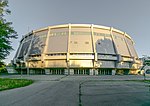Ernst-Happel-Stadion

Ernst-Happel-Stadion (Ernst-Happel-Stadion ), known as Praterstadion until 1992, sometimes also called Wiener-Stadion, is a football stadium in Leopoldstadt, the 2nd district of Austria's capital Vienna. With 50,865 seats, it is the largest stadium in Austria. It was built between 1929 and 1931 for the second Workers' Olympiad to the design of German architect Otto Ernst Schweizer. The stadium was renamed in honour of Austrian footballer Ernst Happel following his death in 1992. The stadium hosted seven games in UEFA Euro 2008, including the final which saw Spain triumph over Germany. The stadium is owned by the City of Vienna (Municipal Department 51 – Sports of the City of Vienna). It is managed by the Wiener Stadthalle Betriebs und Veranstaltungsgesellschaft m.b.H., a subsidiary of Wien Holding. It is a UEFA Category 4 stadium, and as such, it is the home of the Austria national football team. It also hosts the Viennese clubs' matches in UEFA competitions. The stadium is served by Stadion station on the U2 metro line and 11A bus line.
Excerpt from the Wikipedia article Ernst-Happel-Stadion (License: CC BY-SA 3.0, Authors, Images).Ernst-Happel-Stadion
Marathonweg, Vienna KG Leopoldstadt (Leopoldstadt)
Geographical coordinates (GPS) Address Nearby Places Show on map
Geographical coordinates (GPS)
| Latitude | Longitude |
|---|---|
| N 48.207166666667 ° | E 16.420527777778 ° |
Address
Marathonweg
1020 Vienna, KG Leopoldstadt (Leopoldstadt)
Austria
Open on Google Maps








